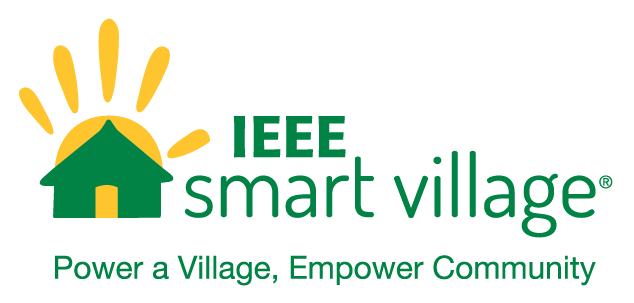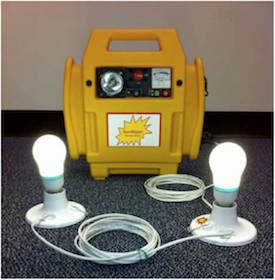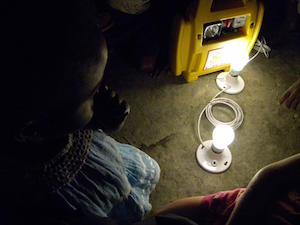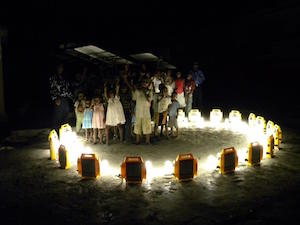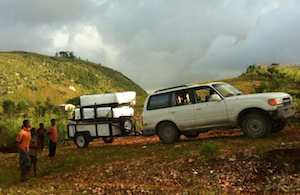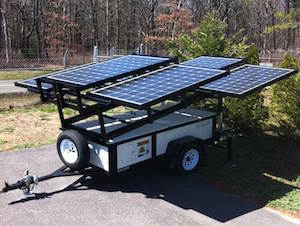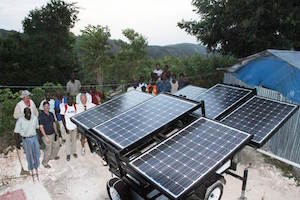IEEE Smart Village – Advancing Technology for All of Humanity
Just a year before the 2010 earthquake in the Caribbean nation of Haiti, IEEE members formed the Community Solutions Initiative working group (CSI) under the parent program Humanitarian Technology Challenge (HTC) pilot of 2008-10. Aimed at making a major impact on reducing world poverty through new technology enterprises growing sustainable infrastructure, human empowerment and community prosperity, CSI teamed up with private industry to design, build and deliver a rapid deployment energy source for off-grid communities.
The problem: Many charitable efforts around the globe have fielded personal-use home solar products of various capacities, but revisiting these systems shortly after deployment often finds them either in disarray or missing altogether due to theft. Only by breaking the conventional mold of charitable contributions could CSI’s lofty goals be realized. This new business model had to target the very causes of energy poverty which includes lack of opportunity, education and market accessibility.
With the Haitian city of Port-au-Prince in ruins from the earthquake and many outlying villages having never been connected to an AC grid, IEEE determined this was the place to demonstrate this new model of sustainability. Haitians use kerosene lamps and candles for illumination which are both dangerous and bad for their health. Villages are dark and unsafe at night.
While most of us don’t think twice about walking into a dark room and flipping a light switch, these villagers lack even this amount of control over their lives. Incredibly, cellular service and cell phones are ubiquitous thanks to a service company that specializes in the Caribbean providing economic service plans so villagers can stay in contact with relatives outside the country. Unfortunately, only the cellular towers are supported with reliable off-grid power while users may walk miles to charge their phones often waiting for someone to carry a 12 volt car battery into the village and then waiting in line.
IEEE determined that addressing lighting and phone charging to start would be a fast path to proving the envisioned impact and more important, the sustainable business opportunity.
In early 2011, IEEE reached out to Nextek Power Systems, a Detroit based renewable energy equipment manufacturer with offices in Long Island, NY, and asked for assistance in designing and building a device that could address the needs of the Haitian villages. The IEEE specifications for this device required that no valuable components reside in the home but instead remain portable since most of the homes are within walking distance of a village center. A central solar powered charging station would become the responsibility of a local franchisee who would be in charge of qualifying customers, operations, collection, and most importantly, security. All ownership and maintenance was the responsibility of the IEEE Partner company, Sirona Cares Foundation.
Portable home battery kits with LEDs were leased to customers on a monthly basis and this payment allowed them to bring the kit back to the station for recharging as needed. In order for the business model to work, pricing had to be compatible with what people were already paying for candles and kerosene. The specification called for a service capability of up to 80 families per charging station (average village size) and a run time for two 40 watt equivalent LED lamps (4 watts ea.) of at least 14 hours between charges. The home kit would also include a second outlet for cell phone charging or small appliances such as a radio, and a built-in flashlight for walking at night to/from the village.
Working with these requirements along with estimating solar radiation figures for Haiti, it was determined that a 1.5kW solar array with 10kWh of battery storage would service all the home battery kits to charge on average every 3 days. A mobile solar trailer with integrated batteries and sub chargers began to take shape whereby four 12 volt 200Ah AGM cells made up the storage component, six 250 watt solar panels would keep them charged and twenty 12 volt sub chargers could be operated simultaneously on two 4 hour shifts per day to charge home kits. The Home kit consisted of a 12 volt 17Ah SLA battery in a carry case modified from a commercial jump-start pack and fitted with low battery voltage cut-off protection. Lighting was provided by two Edison style LED lamps in wall or ceiling mount bases with 15ft of cable between them so they could be used in two rooms or one inside and one outside the home. The system was named “Sunblazer” with panels that could be folded up into a tight package for over-the-road travel.
This first iteration was easy to transport and quick to deploy. Once in place, the pre-wired solar panels were slid out of a central rack like dresser draws and locked; the whole racking system could then be hand cranked to 13 degrees elevation for Haiti’s latitude. Only three circuit breakers would need to be turned on and the system was turning sunlight into cash for the operator and Sirona. Photo illustrated operational manuals were printed in English, French and Kreyol for the operators who were selected by their communities, while technology and business training was provided by both IEEE members who traveled to Haiti and the US NGO, Sirona Cares Foundation.
Nextek was contracted to manage the project including the electrical design of the charging station and the home battery kit, system integration, assembly, field testing and shipping; they also gave many hundreds of hours of volunteer time. The mechanical design was provided by a California firm John Russel Engineering while another Long Island based company, P.A.T. donated 10K sq. ft. of conditioned garage space for final assembly. Between mid-2011 and mid-2012, 15 Sunblazers along with 1200 Home kits were built and shipped from Long Island to Haiti.
The design of the business model was just as important as the hardware. Sirona Cares Foundation pre-screened potential operators who were responsible for a secure site where they would park their Sunblazer, building fences and walls if needed. The villagers embraced the concept that the business was being run by someone they knew and trusted and thus began the transition of ownership that IEEE was looking for as compared to a typical charity. The franchisees themselves had to recruit the customers to fully utilize the station for maximum profits to themselves. Lives were enriched by these simple Sunblazers; people felt secure in their homes; children could do homework at night without noxious fumes; most customers have even made a small business out of charging neighbors cell phones enough to pay for the monthly rental!
These Sunblazers were donated by IEEE as seed funding for the business, after which the partner companies are required to grow on their own to reach millions of people. The deliverable from Nextek is a set of open source plans while the business model to make standard modular solutions for a variety of needs with more electricity capacity for schools, businesses and agriculture is an open-source product of IEEE. Sirona Cares Foundation has followed this model and since the 2011-12 Sunblazer deployment has developed further models that were successfully deployed in rural Haiti[1].
Nextek developed SunBlazers II and III to extend the product line; meanwhile IEEE commissioned four partners in Africa based on the franchise lease business model and will add eight more in Africa and India in 2017. All startups must have strong sustainable community technology, education and business components. The ultimate goal is for hardware to be built in-country for jobs creation using local material and talent trained in the required skill sets.
IEEE’s CSI program has evolved into “IEEE Smart Village”, an IEEE Foundation Signature Program which is continuing to extend the Sunblazer into further refined and larger solar arrays and Microgrids for schools, adult learning centers, shops, homes and agricultural pumping. Open source plans for all these products along with the broad community based educational programs will be available to IEEE Smart Village Partners as it continues its dedication to “Advancing Technology for All of Humanity”.
[1] Sadly we note that the entire successful Sirona operation in over 3,000 homes worth well over $1M was demolished by the 145 mph winds of Hurricane Matthew in October 2016; entire villages have disappeared. Due to the ensuing chaos, reconstruction plans are still not able to begin.
This article first appeared in Renewable Energy World
